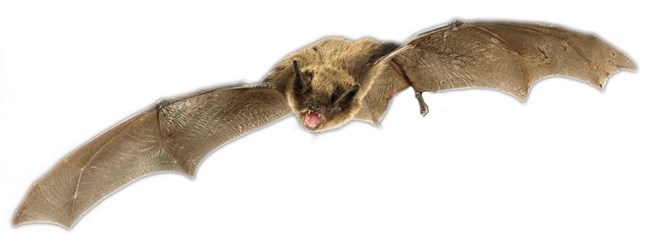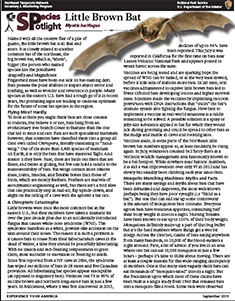Last updated: June 9, 2025
Article
NETN Species Spotlight - Little Brown Bat


Named with all the creative flair of a pile of guano, the little brown bat is all that and more. It is closely related to another common bat of the northeast, the big brown bat, which is, *ahem*, bigger (the person who named species like the pondhawk dragonfly and Magnificent Frigatebird must have been out sick on bat-naming day). Bats possess the polar abilities to inspire abject terror and loathing, as well as wonder and reverence in people. Many species in the eastern U.S. have had a rough go of it in recent years, but promising signs are leading to cautious optimism for the future of some bat species in the region.
Flying Mice? Hardly.
To look at them you might think bats are close cousins to rodents, but believe it or not, bats hang from an evolutionary tree branch closer to humans than the one that led to mice and rats. Bats are such specialized mammals however, that scientists have classified them into a group all their own called Chiroptera, literally translating to “hand-wing.” Out of the more than 5,400 species of mammals on Earth, it is only the bats that have mastered flight. And master it they have. Sure, there are birds out there that are faster, and better at gliding, but few can hold a candle to the maneuverability of bats. Bat wings contain more relative mass, joints, muscles, and flexible bones than those of birds, which are mostly feathers. Feathers are marvels of aerodynamic engineering as well, but there isn’t a bird alive that can practically stop in mid-air, flip upside-down, and alight on the ceiling of a cave with the aplomb a bat can.
A Chiropteric Catastrophe
Little browns were once the most common bat in the eastern U.S., but their numbers have taken a dramatic hit over the past decade plus due to an accidentally introduced fungus that causes white-nose syndrome (WNS). The syndrome manifests as a white, powder-like accretion on the skin around their noses. The reason it is such a problem is it causes bats to rouse from their hibernaculum caves in the dead of winter, a time they should be peacefully hibernating. With no insects and sub-freezing temperatures to greet them, most succumb to starvation or freezing to death.
Since first reported from a NY cave in 2006, the syndrome has wiped out millions of bats in 28 states and five Canadian provinces. All hibernating bat species appear susceptible (as opposed to migratory bats). Vermont lost 75 to 90% of its little brown and northern long-eared bats in just a few years. In Minnesota, where it was first discovered in 2015, declines of up to 94% have been reported. This July it was reported in California for the first time on bats near Lassen Volcanic National Park and appears poised to wreak havoc across the state.
Vaccines are being tested and are sparking hope the spread of WNS can be halted, or at the very least slowed, before it kills tens of millions more bats. In lab tests, oral vaccines administered to captive little brown bats led to fewer infected bats developing lesions and higher survival rates. Scientists made the vaccines by implanting raccoon poxviruses with DNA instructions that “tricks” the bat’s immune system into fighting the fungus. How best to implement a vaccine in real-world situations is a riddle remaining to be solved. A possible solution is a spray or jelly-like substance applied to bat fur which they would lick during grooming and could be spread to other bats as the nudge and nuzzle in caves and roosting sites.
Vaccines aside, in some parts of the Northeast little brown bat numbers appear to, at least modestly, be rising again. In July, volunteers counted 362 furry-fliers in a Vermont wildlife management area historically known to be a bat hotspot. While nowhere near historic numbers, it is still a vast improvement over only 97 in 2012 and has slowly but steadily been climbing each year since then.
Mosquito Munching Machines: Myths and Facts
There are many sayings and myths about bats that have been debunked and disproven, the most well-known perhaps being they have poor eyesight (i.e “blind as a bat”). But one that can still stir up some controversy is the amount of mosquitoes bats consume. Everyone agrees bats have voracious appetites, consuming half their body weight in insects a night. Nursing females have been known to eat up to 110% of their body weight. Mosquitoes definitely make-up a part of that bug buffet but it’s the hard numbers where things get a wee bit dodgy. Across the internet, claims of bats eating anywhere from many hundreds, to 10,000 of the blood-suckers a night abound. First, a bit of advice: if you live in an area where one bat can eat 10,000 mosquitos in just a few hours – perhaps it’s time to think about moving. There are at least a couple reasons for this wide-ranging discrepancy in numbers. One is that many stats vaguely claim bats can eat thousands of “mosquito-sized” insects a night. But the foundation upon which most of these claims have been built is a single study from 1960 that released bats into a mosquito-filled room. Some bats were observed to consume 10 of the insects in 60 seconds. This has led to many back-of-the-napkin falsified extrapolations (new term available for immediate use: falsifipolations) and highly bloated numbers. The problem of course is that bats in the wild have more than one food option to choose from, and most prefer nutritionally superior moths, spiders, and beetles over mosquitoes.

Beyond mosquitoes, bats help control many other agricultural pests in the U.S. to the tune of an estimated $22 billion in annual savings to farmers. A bat house or two in your yard can also be a pesticide-free deterrent for many garden and tree pests. And if they happen to eat a mosquito or two (hundred) to boot, all the better.
The Sound of Sonar
Regardless of the kind of insects a little brown bat eats, the way it finds them while simultaneously avoiding crashing into a tree trunk in total darkness is through the ingenious use of echolocation. This biological sonar works by the bat emitting high-frequency soundwaves and then interpreting the returning echoes to navigate through space and locate prey with pinpoint accuracy. Able to detect objects as thin as a human hair, they can paint highly detailed pictures in their minds of their surroundings.
While the sound emitted by most bat species is out of the range of hearing for humans, many of their prey species have evolved to not only recognize it, but to take evasive action to avoid being eaten. Some moths fly in zigzag, spiral, or looping patterns, and some crickets and beetles make clicking sounds of their own to confuse the signals coming back to bats - a kind of sonar-jamming technique.
Rabidly Exaggerated
Another myth is that the majority of bats carry rabies. The facts bear out however that perhaps as little as ½ of 1% have the disease. Still, this doesn’t mean you should go about handling bats any more than you should any wild animal. Across the world, rabies kills about 59,000 people each year, and almost all those cases are caused from dog bites. People in the U.S. are very good about vaccinating their dogs however, so bats are the main cause of human rabies here - infecting seven of every 10 people who develop the disease according to the Centers for Disease Control.

The Bat House Rules
Besides WNS, another reason bat numbers have been declining is the loss of good habitat for raising young. You may think they are constant cave dwellers, but bats of the northeast only prefer those kind of cold, isolated places for hibernating through the winter. Other times of year they utilize natural and artificial crevices for their roosts. Come June and July, little brown females give birth to a single offspring, and like grouping in small colonies to raise young together in hollow pockets of trees. With such habitat at a premium in our region, bat mothers could use some help. Building (or purchasing) a bat “nursery house” provides an ideal place for your neighborhood bats to raise pups. There are a few simple rules to keep in mind to fulfill their needs: they like it sunny and hot (interior temps of 100F are ideal), the house should be at least 15ft off the ground (to protect from predators), and be near a water source to keep Mom close by. Two of these criteria can often be met on the sunny side of your home’s exterior. Many people even collect the guano beneath, which is one of nature’s best fertilizers.For more information
See Bat Conservation International’s bat house advice so you can help bats in your neighborhood.- Watch this video to learn how bat wings make them an extremely manoeuvrable menace to flying insects.

Tags
- acadia national park
- appalachian national scenic trail
- eleanor roosevelt national historic site
- home of franklin d roosevelt national historic site
- marsh - billings - rockefeller national historical park
- minute man national historical park
- morristown national historical park
- saint-gaudens national historical park
- saratoga national historical park
- saugus iron works national historic site
- vanderbilt mansion national historic site
- weir farm national historical park
- species spotlight
- netn
- inventory and monitoring division
- little brown bat
- white nose syndrome
- diseases & pests
- bats
- bat
